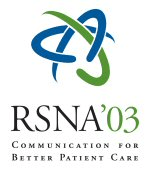
Abstract Archives of the RSNA, 2003
Q04-1235
The Limited Value of Doppler Ultrasound in the Assessment of Hepatic Arterial Complications in the Early Postoperative Period of Living Donor Liver Transplantation: A Prospective Study of 229 Transplants
Scientific Papers
Presented on December 4, 2003
Presented as part of Q04: Gastrointestinal/Ultrasound (Liver Ultrasound)
Kyoung Won Kim MD, PRESENTER: Nothing to Disclose
Abstract:
HTML
Purpose: To evaluate the efficacy of Doppler ultrasound (US) in the assessment of hepatic arterial complications in the early postoperative period of living donor liver transplantation (LDLT).
Methods and Materials: The study group consisted of 229 liver transplants (163 right lobe, 28 left lobe, and 19 bi-lobe transplants) in 211 recipients of LDLT who underwent serial Doppler US examinations in the early postoperative period (< 7 days; 1-4 times; mean, 2.7 times) of LDLT. The examinations were interpreted as having hepatic arterial stenosis or thrombosis, when the hepatic artery showed an abnormal waveform with tardus and parvus pattern (RI < 0.55 and SAT > 0.1 s) or no intrahepatic arterial flow. The verification of the presence or absence of hepatic arterial complications was made by imaging findings on conventional hepatic arteriography (n = 51), MR arteriography (n = 38), or thin-slice CT arteriography (n = 140) and clinical follow-up for six months
Results: Thirteen transplants (6%) had a hepatic artery thrombosis (n = 2) or significant stenosis (n = 11). Initial Doppler US examination on postoperative day one of LDLT showed no intrahepatic arterial flow in 31 patients (14%) and tardus and parvus pattern of waveform in two patients (1%). The sensitivity, specificity, positive predictive value, and negative predictive value of Doppler US on postoperative day one of LDLT were 54, 83, 21, and 97%, respectively. However, among 31 transplants with no intrahepatic arterial flow on the initial examination, 18 (58%) had normal findings, four (13%) showed tardus and parvus pattern of waveform, and nine (29%) showed no intrahepatic arterial flow on follow-up examination at three or seven days of LDLT. An integrated assessment of serial Doppler US examination within seven days of LDLT produced sensitivity, specificity, positive predictive value, and negative predictive value of 69, 84, 60, and 98%, respectively. The Doppler US finding of tardus and parvus pattern of waveform produced a positive predictive value of 83% for the diagnosis of hepatic artery thrombosis or significant stenosis, whereas the finding of no intrahepatic arterial flow produced a value of 44%.
Conclusion: The value of Doppler US for the assessment of hepatic arterial complications is limited in postoperative day one of LDLT because it frequently shows no intrahepatic arterial flow without true hepatic arterial complications. Therefore, to avoid overdiagnosis of hepatic arterial complications, referral to serial follow-up examination or to another imaging modality is mandatory.
Questions about this event email: kimkw@amc.seoul.kr
Kim MD, K,
The Limited Value of Doppler Ultrasound in the Assessment of Hepatic Arterial Complications in the Early Postoperative Period of Living Donor Liver Transplantation: A Prospective Study of 229 Transplants. Radiological Society of North America 2003 Scientific Assembly and Annual Meeting, November 30 - December 5, 2003 ,Chicago IL.
http://archive.rsna.org/2003/3104308.html

